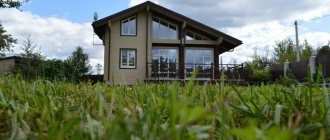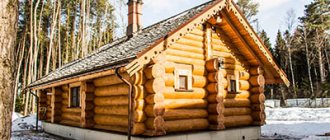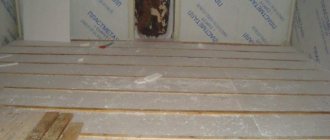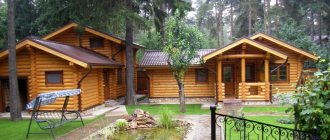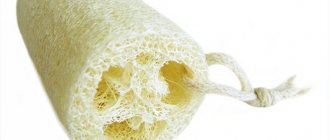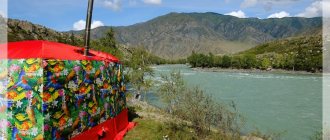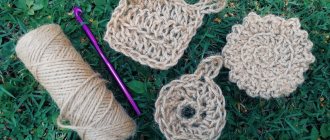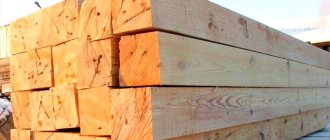A washcloth is a necessary attribute of personal hygiene. Just like a toothbrush, it should be individual for each family member. The effectiveness of hygiene procedures depends on it, so it is important to choose it correctly.
Then it will not only cleanse the skin of impurities. The right body washcloth will act as a massager, get rid of ingrown hairs or cellulite, and replace a scrub. And there is a wide choice - washcloths are made from natural or artificial materials, of different shapes, sizes, and hardness.
Criteria for choosing a washcloth
It is difficult to say for sure which washcloth is better. It depends on skin type, sensitivity, presence of allergic reactions, dermatological problems.
It is important to choose this remedy correctly for people with varicose veins and other cardiovascular pathologies and increased skin sensitivity. If you have moles, papillomas, or wounds, only soft washcloths are suitable.
Small sponges are comfortable to hold in your hand.
In addition to taking into account your skin type, when choosing, you need to pay attention to the features of the washcloth.
- The main thing is to choose the material. Washcloths can be natural or synthetic.
- According to the degree of hardness, the washcloth can be soft, medium hard, hard or combined. Hard options are used for peeling, soft ones are suitable for children or for facial cleansing.
- The size of the washcloth is also important. Small sponges are comfortable to hold in your hand; they are more suitable for anti-cellulite massage or facial cleansing. Large washcloths in the form of a towel, ribbon or braid allow even an elderly person to easily wash all hard-to-reach parts of the body.
- The shape and color of this accessory create the mood while swimming. This is important for children, for whom it is better to buy bright washcloths in the shape of animals.
- The presence of a loop is necessary for convenient holding and storage. Hanging by a loop, the washcloth dries faster.
Synthetic sponges
They are made from nylon, polyester, foam rubber, rubber and other materials. They vary in shape, size, and hardness.
They are often chosen for children, as they are soft, bright, inexpensive, and create abundant foam. But synthetic washcloths are popular not only because of this.
Foam sponges are the softest.
With proper care, they last a long time. They do not create conditions for the growth of bacteria and fungi. There are many types of synthetic washcloths.
- Foam sponges are the softest. They have different shapes, colors, and foam detergents well. But foam sponges tear quickly, take a long time to dry, and bright colors can lead to an allergic reaction.
- Roses made from nylon or nylon thread look beautiful. They are light, compact, dry quickly, and easy to store. They create a lot of foam, but do not cleanse the skin well. Such washcloths quickly become disheveled.
- Polyethylene washcloths in the form of a tape are more suitable for men. They have a rough surface and are convenient for cleaning the back.
- Towels are a piece of fabric. They are often made from nylon threads woven in a special way. There are different hardnesses. Because of its size and shape, it is often called a “vehotka”.
Made from natural material
These are environmentally friendly washcloths. Safe for skin and environment. They do not emit toxic substances and do not contain dyes. There are different degrees of hardness, which depends on the material.
The disadvantages of natural washcloths are that they take a long time to dry and often harbor fungi and bacteria. They foam worse than synthetic ones.
Washcloths made from natural materials are safe for the skin and the environment.
There are several types of natural materials from which washcloths are made.
- Hemp or hemp fibers are used to produce washcloths in their pure form or added to synthetic threads. This material is durable, resistant to various impacts, but tough. Suitable for anti-cellulite massage.
- Washcloths made of linen or cotton absorb water well and create foam. They serve for a long time and do not cause allergies. Usually soft, so suitable for sensitive skin.
- From loofah or a plant called "crazy cucumber". These sponges are cylindrical in shape and usually hollow inside. Detergents foam well. But they are harsh and not suitable for sensitive skin. Due to this property, they are often used as an anti-cellulite massage product.
- Sisal is a fiber obtained from agave leaves. The washcloths turn out to be very hard. Suitable for peeling or anti-cellulite massage. Cannot be used frequently or for sensitive skin.
- Lyko - linden bark. The washcloths are soft and do not cause allergies. They clean out pores and prevent acne. But they foam poorly and tear quickly.
- Sea sponge is very soft. These washcloths are suitable for sensitive skin, facial cleansing, and children. But they are short-lived and expensive.
How and when to sow luffa
Since luffa is a heat-loving plant, in the middle zone it is most often grown in greenhouses in seedlings, and in regions with hot, long summers it can be grown in open ground. Given the long growing season (150-200 days, depending on the type and variety), seeds begin to be prepared for planting in the first ten days of March. First, they are heated for 7-10 days at a temperature of about 35°C, then soaked and kept in a damp cloth for several days at a temperature of 25-28°C.
Sow swollen or sprouted seeds into cups with nutritious soil to a depth of 15-20 mm, cover with glass and place in a warm place. As soon as the shoots appear, remove the glass and transfer the containers to a well-lit place where the temperature is 20-22°C. The seedlings are watered as the soil dries out, and 10 days before planting the seedlings in the ground, the plants are fed with complex organomineral fertilizer.
Soft washcloths
Soft washcloths are often chosen by children or people with sensitive skin. When used correctly, they effectively remove dirt, have a light massage effect, and whip up foam well. But such washcloths do not clean well, so they are not suitable for everyone.
Kelebek Kese mitten – soft
Kese is a glove used in Turkish baths for body massage and exfoliation. Apply to steamed skin; no need to apply gel or soap. Made from silk and cellulose fibers. This is the best washcloth for thin and sensitive skin and facial cleansing.
Rolls off dead skin cells, removes impurities, opens pores. This massage improves blood circulation. Cosmetics applied after it are more effective. The washcloth is made in the form of a mitten with a loop. After use it must be dried.
Pros:
- high-quality material that does not cause allergies;
- soft, suitable for the face;
- inexpensive.
Minuses:
- slips off the hand;
- does not exfoliate the skin well.
Sung Bo Cleamy Corn Shower Towel – in the form of a towel
This towel measures 28 by 110 cm. Made from nylon threads. The washcloth scrubs the skin well, but does not injure it, as it is soft.
The size allows you to wash all parts of the body and conveniently rub your back. Thanks to the rough surface, it improves blood circulation, makes the skin smooth, and cleanses. Helps to relax and relieve muscle tension. The washcloth can be used daily.
Pros:
- big;
- convenient to use;
- creates a lot of foam;
- strong and durable;
- soft, suitable for sensitive skin;
- has a massage effect.
Minuses:
- difficult to adjust to size;
- the edge is not processed.
Convenient crocheted accessory with long loops
To crochet a bath masterpiece you will need the following materials and tools:
- polypropylene threads;
- medium size hook (no. 4 is suitable).
Note! The hook should not have a too sharp head, as it may tear the threads.
I provide step-by-step instructions according to which you can easily knit a wonderful washcloth for your man.
1.) First part. Warp knitting. The process looks like this:
- take a skein of polypropylene thread;
- the required amount of material is unwinded;
- two strings are put together;
- a neat noose loop is made for the hook;
- a chain consisting of air loops is knitted - the thread is grabbed and pulled through the loop;
- the chain closes into a ring.
2.)Edge. Tying the ring with single crochets. The process consists of the following stages:
- The hook is inserted into the loop of the ring from front to back;
- the working thread is grabbed and pulled through the loop;
- the working thread is pulled through two loops on the hook;
- the column of the second row is knitted through the loops of the first;
- the column of the third row is knitted through the loops of the second;
- The column of the fourth row is knitted through the loops of the third.
3.) The main part of “Shaggy”. Knitting columns with double crochet. The process looks like this:
- the working thread is thrown onto the hook;
- insert the hook into the loop of the previous row;
- the working thread is grabbed from both sides so that a loop is formed on the finger;
- two threads are pulled through the loop of the row, after which the thread is thrown off the finger (four loops should form on the hook);
- the hook grabs the working thread and pulls it through the first two loops (two loops remain on the hook);
- the hook grabs the working thread and pulls it through the loops that remain;
- a row is knitted;
- the washcloth is turned inside the loops inside - for convenience;
- columns with elongated loops are knitted until the accessory is the desired length.
4.) Handles. Knitting of comfortable handles. The process looks like this:
- a single crochet is knitted into the first loop of the row;
- a chain is made from the resulting loop (the length of the chain is the length of the handle);
- several single crochets are knitted to secure the end of the chain;
- the handle is tied in the same way as the canvas, or rather its beginning;
- two or three loops are knitted in the edge of the product;
- the loop is pulled out, the knot is tightened and the thread is cut.
5.) Final stage. The accessory is turned “shaggy” outward.
That's all! The pattern is simple, but the washcloth turns out great. This bath accessory will be a great gift for your man. And if you also sew a soft towel and make fragrant soap, you will get a wonderful set for a bath. Create and delight, lovely young ladies!
Medium hard sponges
This is ideal for all skin types. Gently exfoliate, remove impurities, but do not damage the upper layer of the epidermis. This washcloth is suitable for massage and activates blood circulation. Frequent use is not recommended for people with sensitive skin.
KAI Body washcloth – towel with plant fibers
The washcloth is made in the form of a towel measuring 100 by 30 cm. It washes well, opens pores, and forms lush foam. Made from cotton fabric with the addition of hemp fibers.
Has a massage effect and increases blood circulation. Can be used for sensitive skin. Wash with soap and shower gel. May cause allergic reactions.
Pros:
- natural material;
- can be folded and used as a sponge;
- easy to wash, dries quickly;
- medium hardness.
Minuses:
- difficult to adapt to size;
- expensive.
OH:E Cure series - 100% nylon
This towel measures 100 x 28 cm. Made from nylon fiber. Has a massage effect, cleanses, opens pores. But it does not injure even thin skin, but invigorates, makes it smooth and soft. The fabric is thin, easily bunches up, and creates a lot of foam. Suitable for daily use.
Pros:
- convenient to use;
- foams any soap well;
- easy to rinse;
- convenient to take on trips - lightweight, dries quickly;
- resistant to high temperatures;
- strong and durable.
Minuses:
- some find it too soft and thin;
- difficult to get used to because of the size;
- expensive.
Hard washcloths
Hard washcloths are designed for deep cleansing of the skin. They remove any dirt and have a massage effect. Women use it for peeling and fighting cellulite. It is not recommended to use hard washcloths more than 1-2 times a week.
Kokubo Gachi-Men Body Towel – for men
A long and narrow towel measuring 110 by 20 cm. The ribbed surface provides a massage effect, cleanses any dirt well, even after sports, and absorbs sweat.
Creates abundant foam, thin, easy to form into a lump. When unfolded, it is convenient to wash your back. The structure of the fibers creates a massage effect and stimulates blood supply to the epidermis.
Pros:
- lightweight, does not take up much space;
- dries quickly;
- massages the skin;
- cleans well;
- creates a lot of foam from any detergent.
Minuses:
- not hard;
- thin, not everyone can use it conveniently.
Zeitun kese – for peeling
The washcloth mitten has a rigid structure. Designed for cleansing, peeling, massage. Removes dead skin, sebaceous plugs, opens pores.
Effectively eliminates cellulite - warms up, speeds up metabolic processes. Polishes, makes the skin smooth and soft. Soap foams well and can be used after cleansing and steaming the body.
Pros:
- does not injure;
- massages;
- creates lush foam;
- durable;
- fits comfortably on the hand;
- can be used for peeling.
Minuses:
- Do not rub delicate skin with moles or papillomas;
- expensive.
Sponges
Body wash sponges come in different hardnesses and are made from natural or synthetic material. Feature – they absorb detergents well and create abundant foam. After use, sponges must be rinsed and dried well.
Fresh idea Massage – with anti-cellulite effect
Sponge made of dense, large-pored foam rubber. Foams soap well, creating a stable foam. On one side the surface is smooth and even, on the other there is a massage layer with an anti-cellulite effect.
It's wavy and cleanses and exfoliates well. The sponge size is 14 by 9 cm, height 5 cm. Therefore, it fits comfortably in the hand. Easy to wash, dries quickly.
Pros:
- cleanses;
- creates a massage effect;
- does not scratch the skin.
Minuses:
- may cause irritation and itching;
- not suitable for sensitive skin.
Kokubo LADY`s Fish – medium hard
Sponge in the shape of a fish with a massage effect. Exfoliates dead skin cells and can be used for peeling. Two-layer, medium hardness, quickly foams even a small amount of soap. Massages, improves blood circulation.
An interesting shape creates a good mood. It dries easily and is conveniently attached to the shelf using a cut.
Pros:
- massage effect;
- creates a lot of foam;
- comfortable to hold in hand.
Minuses:
- no loop;
- Not tough enough for peeling.
Silva natural (SW 272) – made from loofah
A hard, natural cylindrical sponge made from a plant. Size 13 by 8 cm. Provides deep peeling, cleanses pores, and has a massage effect. Can be used for anti-cellulite massage, as it activates blood circulation and metabolic processes in the skin.
If soaked in hot water for 15 minutes, it becomes soft. Luffa does not cause allergies, but is not suitable for people with sensitive skin, moles, and skin diseases.
Pros:
- natural material;
- holds foam;
- massages, has anti-cellulite and lymphatic drainage effect;
- cleanses;
- strong, durable;
- Convenient loop for storage.
Minuses:
- hard;
- needs to be softened before use.
How to care for a luffa
Cylindrical luffa
Luffa seedlings are transplanted when the threat of return frosts has passed and the soil has warmed up to 13-15°C. Seedlings can be transplanted into an airtight greenhouse as early as mid-April. In open ground - a few weeks later, under temporary shelter. For planting, choose a sunny area with fertile soil. Several handfuls of humus, vermicompost or compost are added to the planting holes and watered with a solution of biofungicide based on Bacillus subtilis or Trichoderma.
Luffa develops quite quickly, actively increasing its green mass, and therefore requires regular organic and mineral fertilizing. 2-3 weeks after planting in the ground, you can water the plants with mullein infusion, diluting it with water in a ratio of 1:10. During the flowering period, fertilizers such as superphosphate, nitroammophoska and wood ash infusion are suitable. During fruiting, plants need potassium supplementation, so potassium sulfate or monopotassium phosphate (monopotassium phosphate) can be used. Fertilizers are dissolved in water according to the recommendations on the package. Liquid fertilizing is the most effective method, since with water nutrients penetrate to the roots much faster.
An important rule for growing luffa is that it must be tied to a support. If you do not create support and the stems spread on the ground, the fruits will grow deformed. To obtain beautiful and even sponges, the fruits should hang freely. As a support, you can use trellises or nets for tying cucumbers.
- How to tie cucumbers in the garden - the best tips and ideas with photos
On the eve of the planting season, we remind you of the basic methods of forming cucumber bushes and tell you about new products.
Luffa should be watered as the soil dries: the ground should always be slightly moist, since the root system of the plant is located in the surface layer of soil. To prevent the roots from drying out and the plants not having to be watered too often, it is advisable to mulch the soil. At the beginning of autumn, after the fruits have formed and begin to ripen, the amount of watering is reduced.
In the middle zone, luffa fruits do not always have time to ripen before the onset of cold weather. Therefore, plants must be shaped: remove side shoots in a timely manner, and pinch out the central stems after they reach three meters. On one cylindrical luffa bush, it is enough to leave 5-7 ovaries, on a sharp-ribbed bush - up to 10. If this is not done, all the plant’s energy will be directed to growing green mass, and not to the formation of fruits.

